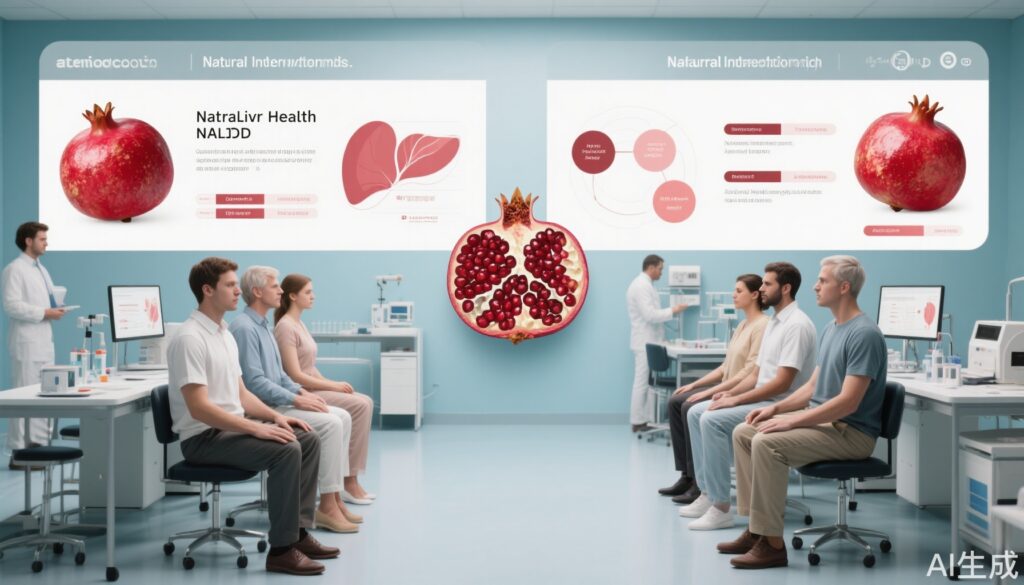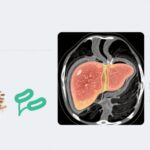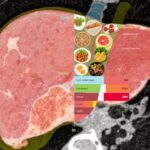Highlights
- Pomegranate peel extract supplementation led to significant improvements in liver enzymes (ALT, AST), triglycerides, HDL-C, and hs-CRP in NAFLD patients.
- No significant change was observed in LDL-C, total cholesterol, other liver function markers, or liver steatosis grade.
- The findings support the antioxidant and anti-inflammatory potential of pomegranate peel as an adjunct in NAFLD management.
- Larger and longer-term studies are needed to confirm efficacy and safety.
Study Background and Disease Burden
Non-alcoholic fatty liver disease (NAFLD) is currently the most common chronic liver disorder globally, affecting an estimated 25% of adults. NAFLD encompasses a spectrum from simple hepatic steatosis to non-alcoholic steatohepatitis (NASH), which may progress to cirrhosis and hepatocellular carcinoma. Despite its prevalence and associated metabolic comorbidities—including type 2 diabetes, dyslipidemia, and cardiovascular disease—no pharmacological therapy has yet been conclusively proven to treat NAFLD. Pathogenesis involves complex interactions between lipid metabolism dysregulation, insulin resistance, oxidative stress, and inflammation, suggesting that interventions targeting these pathways could be beneficial.
Pomegranate peel extract (PPE) is rich in polyphenols and demonstrates potent antioxidant and anti-inflammatory properties in preclinical models. These bioactivities provide a rationale for investigating PPE as a complementary approach for metabolic liver disorders such as NAFLD.
Study Design
This was a double-blind, placebo-controlled, randomized clinical trial conducted by Baghdadi et al. (2025), enrolling 46 adult patients diagnosed with NAFLD. Participants were randomized (1:1) to receive either:
- Pomegranate peel extract: Two capsules daily (each containing 500 mg PPE) for 10 weeks, alongside a calorie-restricted diet (500 kcal/day deficit).
- Placebo: Two capsules daily (each containing 500 mg maltodextrin), with the same dietary guidance.
Demographics, anthropometric indices, dietary intake, physical activity, liver steatosis grade (ultrasound), liver enzymes (ALT, AST, ALP, GGT), lipid profile (TG, HDL-C, LDL-C, TC), and high-sensitivity C-reactive protein (hs-CRP) were assessed at baseline and study end. Dietary intake was evaluated via 24-hour recall, and physical activity was quantified by the International Physical Activity Questionnaire (IPAQ).
Statistical analyses were performed using SPSS v22, with significance set at p < 0.05. Of the initial 46 participants, 42 completed the trial (n=21 per group).
Key Findings
The primary findings after 10 weeks of intervention were as follows:
- Triglycerides (TG): The PPE group had a significantly greater reduction in serum TG compared to placebo (p = 0.02).
- Liver Enzymes: Significant decreases in ALT (alanine aminotransferase, p = 0.02) and AST (aspartate aminotransferase, p = 0.01) were observed in the PPE group versus placebo, indicating potential hepatoprotective effects.
- HDL-C: The PPE group experienced a significantly greater increase in high-density lipoprotein cholesterol (HDL-C) (p = 0.04).
- Inflammation: hs-CRP, a systemic marker of inflammation, was significantly reduced in the PPE group (p = 0.01).
- No Significant Changes: LDL-C, total cholesterol, alkaline phosphatase (ALP), gamma-glutamyl transpeptidase (GGT), and liver steatosis grade (as assessed by ultrasonography) did not differ significantly between groups at study end.
All groups adhered to similar dietary and physical activity regimens, reducing confounding. No serious adverse events or tolerability issues were reported.
Expert Commentary
These findings are noteworthy as they suggest that PPE supplementation can beneficially modulate key metabolic and inflammatory parameters in NAFLD. The improvements in ALT and AST, widely regarded as surrogate markers of hepatic injury, may reflect attenuation of hepatocellular damage. The triglyceride-lowering and HDL-C–raising effects further underscore the cardiovascular metabolic benefits.
The lack of effect on LDL-C, total cholesterol, and hepatic steatosis grade may be attributable to the short study duration (10 weeks), relatively modest sample size, and the intrinsic limitations of ultrasonography in detecting minor changes in hepatic fat content.
From a mechanistic standpoint, the observed improvements align with the antioxidant and anti-inflammatory actions of pomegranate polyphenols, which may counteract oxidative stress and low-grade inflammation fundamental to NAFLD pathogenesis. However, the trial’s findings should be interpreted cautiously, as dietary and physical activity interventions are known to independently improve liver-related outcomes.
Given the absence of proven pharmacotherapies for NAFLD and the growing interest in evidence-based nutraceuticals, PPE may represent a promising adjunctive therapy. Larger, longer-duration trials with histological endpoints and mechanistic biomarker analyses are warranted to validate these findings and inform clinical guidelines.
Conclusion
This randomized controlled trial demonstrates that pomegranate peel extract supplementation, combined with a calorie-restricted diet, leads to significant reductions in hepatic transaminases, triglycerides, and systemic inflammation, while increasing HDL-C in patients with NAFLD. However, no significant changes were observed in LDL-C, total cholesterol, or liver steatosis grade over 10 weeks. These results highlight the therapeutic potential of PPE as an adjunct in NAFLD management, pending further research on optimal dosing, long-term safety, and efficacy.
References
Baghdadi G, Shidfar F, Mokhtare M, Sarbakhsh P, Agah S. Effect of Pomegranate Peel Consumption on Liver Enzymes, Lipid Profile, Liver Steatosis, and Hs-CRP in Patients With Non-alcoholic Fatty Liver Disease: A Double-Blind, Placebo-Controlled, Randomized Clinical Trial. Phytother Res. 2025 Feb;39(2):619-629. doi: 10.1002/ptr.8404.
For further reading on NAFLD management and nutraceutical interventions, see:
Younossi ZM, Rinella ME, Sanyal AJ, et al. From NAFLD to MAFLD: Implications of a premature change in terminology. Hepatology. 2021;73(3):1194-1198. doi: 10.1002/hep.31432.
Eslam M, Sanyal AJ, George J; International Consensus Panel. MAFLD: A consensus-driven proposed nomenclature for metabolic associated fatty liver disease. Gastroenterology. 2020;158(7):1999-2014.e1. doi: 10.1053/j.gastro.2019.11.312.


